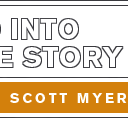Joseph Campbell word for word on The Hero’s Journey
Verbatim transcript from the excellent interview series “The Power of Myth.”
Bouncing around the online writing universe, I invariably run into a lot of chatter about Joseph Campbell and The Hero’s Journey. However, there is a surprising amount of content out there which distorts what Campbell himself said about his theory. So I thought it would be a good idea to hear directly from the man — word for word.
The following iteration of The Hero’s Journey is transcribed verbatim from Campbell’s interview with Bill Moyers in the wonderful PBS series, “The Power of Myth.”
The Hero is found in the ordinary world…
In ancient myths it used to be the cottage or village…
In films, it is usually the suburbs or common urban environment.
The Hero is making do, but feels something missing, a sense of discomfort or tension. The Hero needs to change, even if they are unaware of that need.
Something happens…
Maybe the Antagonist enters the Protagonist’s world, disrupting it. Or maybe someone comes, a Herald, who calls the Protagonist to action.
The call to adventure is about transformation and that’s terrifying. The Hero has to confront fear.
Will the Hero survive?
Will they change for the Good or the Bad?
During the first half, the Hero is tested…
The Hero has to determine the rules of the Extraordinary World into which they are moving — Who can the Hero trust?
Along the way, the Hero meets “threshold guardians,” people who guard the entrances… The trick to facing any opponent is to get into their skin, understand their habits, maybe make them friends and allies.
The midpoint from a mythological standpoint is that moment when the Hero confronts that which they fear most, often related to entering the headquarters of the enemy.
Afterwards, the Hero feels the consequences of the Midpoint… Reflects on their task, often a chance to rest…
Then a chase scene often occurs…
The enemy has been struck a mighty blow, but recovers enough to mount one final act.
A black moment where it looks like all is lost, there is no way to defeat the enemy.
The final test…
To demonstrate whether the Hero has learned his lesson or not…
The process has purified him to ensure that he hasn’t become part of the Other World — but will he succeed?
The Hero returns home with some booty, an elixir, the source of power from the Other World, i.e., treasure, Holy Grail, knowledge, gold, love, wisdom, humility.
In the end, the Hero is a transformed individual.
For all the discussion among writers about The Hero’s Journey, this is pretty much all you need to know.
Separation from the Old World.
Initiation in the New World.
Return to the Old World.
The theme of The Hero’s Journey: Follow your bliss. Through their adventure, the Heroine discovers the most essential and authentic part of her psyche, embraces it, and as a result is empowered to win the final test, thus returning home a “transformed individual,” the physical journey servicing the Heroine’s psychological journey.
It’s that simple. However, it is profound in its simplicity. Moreover, we can apply this narrative archetype to a majority of mainstream movies.
And for us writers? The Hero’s Journey has endless variations if we allow ourselves to enter into the lives of our characters and enable them to lead us into and through the story-crafting process.
So my advice? Don’t get hung up with complicated analyses of The Hero’s Journey, rather better to take a macro view. The version cited above, a literal transcription I typed up of Campbell’s actual words, should be your guide and touchstone.
You can watch clips and access transcripts for all six episodes of “The Power of Myth” series here.
